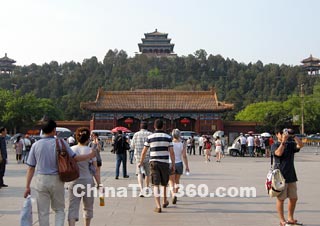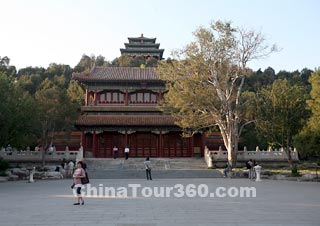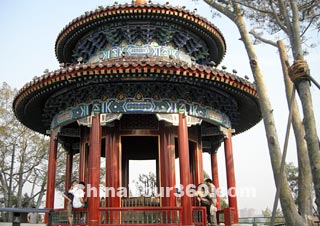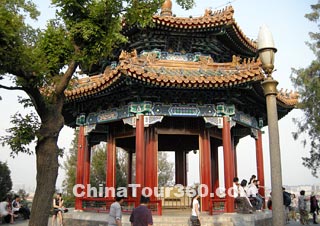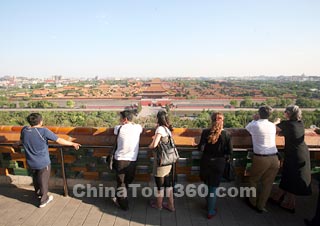Self-guided Jingshan Park Tour
"Jingshan Park Tour from South Gate"
- Code: JS01
Jingshan Park, which has a history of 800 years, is one of the oldest and best preserved Royal gardens in China. It gains favor from many tourists not only because of its beautiful scenery, but more importantly because of its special location from where one can overlook the city of Beijing. Being the highest point on the north-south axis of Beijing, people can have a panoramic view of the Forbidden City, as well as the surrounding buildings.
|
|
The park is located on the north side of the Forbidden City. There are many public buses to the park like bus No. 58, 60 where you can get off at East Street of Jingshan, or bus No. 101, 103, 109, 812, 812 where you can get off at the Forbidden City. The park opens from 06:30 to 21:00 and the entrance fee is CNY2.00 net for regular days. It is easy to visit Jingshan Park by yourself, however, it would be more interesting if you hire a guide or rent an explain device so as to learn some stories of Chinese history.
The park has three gates, South Gate, East Gate and West Gate. Entering from different gates, the sightseeing spots you will see are slightly different. While, the most popular route is to enter from South Gate and exit from East Gate. After you finish the tour of the Forbidden City and get out from Shenwu Gate, you may enter Jingshan Park directly from the South Gate.
The first spot you will visit is Yiwang Tower. It is located just inside of the South Gate, standing at the foot of Jing Hill. The tower was built in the year of 1750, the Qing Dynasty. It was the place where students of official school worshiped the great hierophant Confucius. A memorial tablet of Confucius was placed here which indicated the imperial government's advocating of Confucianism at that time.
|
|
Keep walking eastward, you will see a skew and short locust tree. It is a must to see when people travel to Jingshan Park, and you will learn a story about Emperor Chongzhen as it was the place where he hanged himself. Emperor Chongzhen, named Zhu Youjian, was the last emperor of the Ming Dynasty. When he ascended the throne, the country was in a crisis at that time. He was facing the problem of foreign aggression from late Jin Dynasty (Hou Jin), and also the internal insurgence from peasantry. During 17 years of his reign, he was conscientious, diligent and thrifty, but still was powerless to save the dynasty.
On Mar 18th of the year 1644, Beijing was breached by the insurrectional army under the leadership of Li Zicheng. Being not willing to live with humiliation, Emperor Chongzhen refused to surrender. He sent the Crown prince and other sons out of the city, compelled his empress to suicide, and killed several of his concubines. Then he climbed to the Coal Hill (named Jingshan nowadays), wrote a posthumous edict with his blood, covering his face with hair and then hanging himself on an old locust tree. The original tree has been chopped off and the one people can see today was transplanted in the year 1981.
After the tour of the locust tree, you may keep walking northward and come to Zhoushang Pavilion and Guanmiao Pavilion. There are five pavilions in Jingshan Park, Zhoushang Pavilion, Guanmiao Pavilion, Wanchun Pavilion, Jifang Pavilion and Fulan Pavilion. Originally, each of them had an oblate Buddha which represented acid, sweet, bitter and spicy hot respectively. However, they were plundered by aggressor during the war in the year 1900.
|
|
The tour to Zhoushang Pavilion and Guanmiao Pavilion is not necessary, as they have similar construction style with the two pavilions you just visited. Then we will go for the most important site in this park, which is Wanchun Pavilion. Wanchun Pavilion is the main reason for people traveling to Jingshan Park. This is the highest point on the north-south axis of Beijing, and it is the best place to overlook the full view of the Forbidden City. Most people like to come here for photography. Standing in the pavilion, you will see the magnificent Forbidden City on the south, the famous National Theater on the southwest, the delicate Beihai Park on the west, the Di’anmen Street and Drum Tower on the north, and if luckily the weather is unclouded, the newly built CCTV Tower on the east.
After the trip, you may go down the hill and depart from the East Gate.
The Jingshan Park journey does not take too much of your time. Usually one hour would be enough. You may combine the tour to Beihai Park and the Forbidden City in one day as they are close to each others. Besides, Jingshan Park is also the biggest garden to enjoy peony in Beijing. If you happen to travel during May, you should not miss it.



